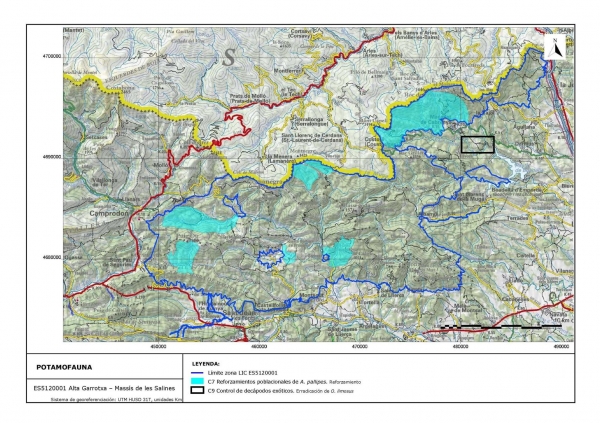Alta Garrotxa - Massís de les Salines
Area: 38,196.100 ha.
The Natura 2000 area of Alta Garrotxa and the Massís de les Salines (ES5120001) includes within its limits three areas of natural interest (EIN) declared by the Government of Catalonia in its PEIN (Pla d’Espais d’Interès Natural). These are the Alta Garrotxa, Massif de Salines and of the Penya-Segats de la Muga. The Catalan government has also declared natural reserves the River Muga in Albanyà.
The area covers the whole of orographic pre-Pyrenees mountains of Alta Garrotxa Massís de les Salines, and a complex of rugged mountains with numerous rivers and valleys. In these reliefs are quite important the maritime winds that determine a trend humid Atlantic climate. The geology is predominantly limestone with lithological units where calcarian materials are very important and where karst phenomena is present. The sunny slopes are characterized by a typical Mediterranean landscape of oaks, while the shaded background exemplify a sub-Mediterranean and Euro-Siberian landscape with beech, oak and Scots pine. It is characterized by one of the best populations of little oak (Quercus rotundifolia) in Catalonia.
The workspace of the project does not include the entire space SCI. Here the project area focuses only on streams and rivers, implying a very small area centered around these aquatic environments where the key LIFE projecte species live.
The space has been built primarily to conserve populations of White-clawed Crayfish (Austropotamobius pallipes). The catalogue of threatened fauna of Catalonia (pending approval) considered the species endangered (their short-term survival is unlikely). It is currently expanding its distribution in Catalonia, but very localized and fragmented, especially in small rivers and streams undisturbed.
The situation of the crayfish in river Fluvia, which includes part of the Alta Garrotxa, is extremely delicate. The populations are located on the higher streams where due to a natural barrier (drought, cliffs ...) the crayfish plague –afanomicosis fungus- has not been reached yet. Currently populations suffer the threat of the spread of the american crayfish. Between 1998 and 2002 censuses were conducted to know the population and to locate several areas of interest, which have been the subject to special conservation and care. Some crab populations have also been founded within the natural basin of the Muga.

















